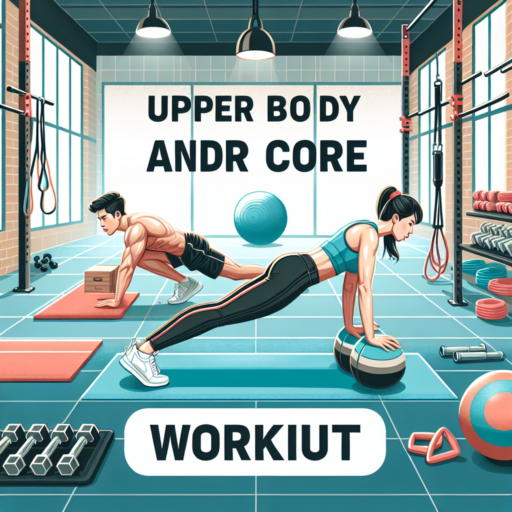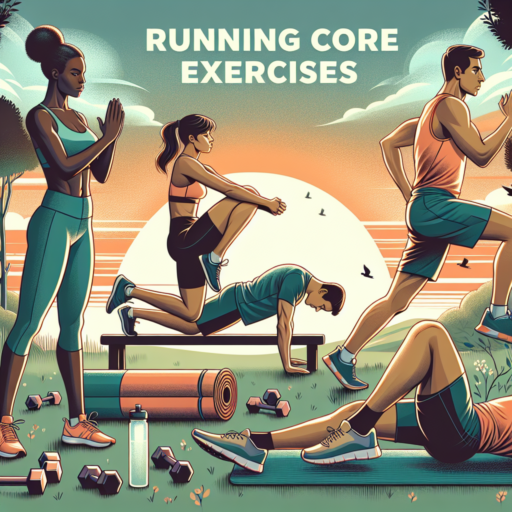Introduction to Upper Body and Core Workouts
Engaging in upper body and core workouts is essential to building strength, stability, and achieving a balanced physique. These exercises not only enhance muscle tone but also improve overall functionality, enabling us to perform daily activities with greater ease and prevent injuries. The importance of incorporating these workouts into your fitness regimen cannot be overstated, as they target key muscle groups including the chest, back, arms, shoulders, and the core—comprising the abdominal muscles, lower back, and pelvic area.
Beginning a routine focused on the upper body and core can seem daunting at first. However, the versatility of exercises available means that individuals at any fitness level can find movements that work best for their abilities and goals. From push-ups and pull-ups that utilize body weight for resistance, to weighted exercises like dumbbell presses and rows, there’s a vast array of options to explore. Additionally, engaging in planks and sit-ups will significantly enhance core strength, providing the stability needed for not only other workouts but for improving posture and reducing the risk of back pain.
For those new to these types of workouts, starting with basic movements and gradually increasing intensity and variety is key to building strength safely. Incorporating a mix of bodyweight exercises, resistance training, and core-focused movements into your routine will ensure a comprehensive approach to strengthening the upper body and core. This holistic perspective not only promotes muscular development but also enhances endurance, coordination, and flexibility.
The Importance of Strengthening Your Upper Body and Core
Understanding the critical role that a strong upper body and core play in overall health and performance can transform your fitness journey. When you focus on building strength in these areas, you’re not just improving your physique; you’re enhancing your functionality in day-to-day activities and reducing your risk of injuries. These regions are pivotal for maintaining balance, stability, and power in most physical tasks.
Upper body strength is crucial for daily activities that involve lifting, pushing, and pulling. Whether you’re carrying groceries, picking up a child, or moving furniture, a strong upper body ensures these tasks are performed efficiently and without strain. Moreover, focusing on your upper body can improve posture and alleviate the pressure on your lower back, which often results from a weak core and upper body musculature.
A robust core, which includes your abdominals, back muscles, and pelvic muscles, acts as the central link between your upper and lower body. A strong core enhances balance and stability, preventing falls and injuries. It also plays a vital role in performing any physical activity. A well-conditioned core helps with power generation for athletes and provides the much-needed support for endurance and performance in various sports and activities.
No se han encontrado productos.
Top 10 Upper Body and Core Exercises You Should Know
Building a strong upper body and core doesn’t just contribute to a well-shaped physique; it also enhances your functional strength, aiding in daily activities and boosting your overall fitness. Including a variety of exercises that target different muscle groups is essential for balanced development. Below, we delve into some pivotal moves that should be part of your routine.
Essentials for a Solid Upper Body and Core
The synergy between upper body and core strength is undeniable. Exercises that simultaneously engage multiple muscle groups not only provide a more efficient workout but also mirror the complex movements found in real-life activities. Incorporating these exercises into your sessions ensures a comprehensive approach to muscle development and functional strength.
Integrating Exercises into Your Routine
It’s not just about knowing what exercises to do; it’s also about how you execute and integrate them into your workouts. Variation, proper form, and gradual progression are key components of an effective exercise regimen. Emphasizing the integration of compound movements, which engage various muscle groups simultaneously, can lead to more dynamic strength gains and a more well-rounded physique.
Equipment-Free Upper Body and Core Workout for Beginners
Embarking on an upper body and core workout doesn’t have to involve expensive equipment or complex machinery. For beginners, the journey to strength and fitness can begin right in the comfort of their own home. Focusing on equipment-free exercises allows individuals to get acquainted with their body’s capabilities and limitations, fostering a solid foundation for more advanced fitness pursuits in the future.
Exercises like push-ups, planks, and burpees not only strengthen the chest, shoulders, and arms but also engage the core, providing a comprehensive workout that builds muscular endurance and stability. For beginners, modifying these exercises to meet their current fitness level is essential. For instance, starting with knee push-ups before advancing to traditional push-ups can help in gradually increasing upper body and core strength.
Incorporating dynamic movements such as mountain climbers and inchworms can further enhance core activation, while also improving cardiovascular health. These exercises, performed in succession, can simulate the intensity of a high-intensity interval training (HIIT) session, maximizing calorie burn and improving metabolic health, all without the need for any equipment.
Building Your Workout Routine: How to Effectively Combine Upper Body and Core Exercises
Designing a balanced workout routine that effectively integrates upper body and core workouts is crucial for achieving a harmonious physical development and maximizing your exercise efficiency. Combining these areas not only enhances muscle tone and strength but also improves posture and functional movements. To start, familiarize yourself with the fundamental exercises for each area and consider how they complement each other.
Understanding the Benefits of Combining Upper Body and Core Workouts
When you merge upper body exercises with core training, you support the development of a solid foundation for all other movements. A strong core enhances your balance, reduces the risk of injuries, and improves your capability to perform upper body workouts more effectively. For instance, exercises like planks or push-ups target both the core and various upper body muscles, thereby maximizing workout efficiency and results.
Creating a Balanced Routine
Begin with a plan that allocates equal attention to strength training for the upper body and core development. Incorporate compound exercises such as bench presses or pull-ups that engage multiple muscle groups, including the core, for a full-body effect. Equally important is to blend in specialized core exercises like Russian twists or bicycle crunches to specifically fortify the core muscles. Alternating between upper body and core exercises can keep the workouts engaging and comprehensive.
Remember, consistency and progressive overload are key. Gradually increase the intensity of your workout by adding weights, reps, or complexity to the exercises. This approach ensures continuous improvement and helps avoid plateaus. By keeping these strategies in mind, you can create a holistic and effective workout routine that fosters upper body strength and a robust core.
Advanced Upper Body and Core Workouts for Increased Strength
Exploring Advanced Upper Body and Core Workouts is essential for anyone looking to enhance their physical strength, agility, and overall fitness levels. By focusing on these areas, individuals can improve their performance in various sports, maintain a healthy posture, and reduce the risk of injuries. Upper body strength is pivotal not only for daily activities but also for developing a balanced physique that supports proper movement patterns.
Integrating compound exercises is a strategic approach to target multiple muscle groups simultaneously, making your workout routine more efficient and challenging. Exercises such as pull-ups, push-ups, and bench presses are fundamental for building a strong upper body. However, to achieve greater strength, one must also incorporate movements that challenge the core, ensuring a solid foundation for advanced upper body workouts. Planks, Russian twists, and hanging leg raises are excellent for engaging core muscles, providing the stability needed for heavier lifts and advanced exercises.
Periodization and progressive overload are key concepts to adhere to when pursuing increased upper body and core strength. Gradually increasing the intensity of your workouts by adding more weight, altering the number of reps, or incorporating different sets of exercises prevents plateauing and promotes continuous growth. Keeping track of your progress, setting realistic goals, and pushing your limits within safe boundaries are integral steps towards achieving exceptional results in upper body and core conditioning.
Tips for Maximizing Your Upper Body and Core Workout Results
Maximizing your upper body and core workout results requires not just dedication but also implementing the right strategies to enhance muscle growth, strength, and definition. One fundamental tip is to focus on compound exercises. These exercises, such as push-ups, pull-ups, and planks, engage multiple muscle groups simultaneously, leading to more comprehensive strength development and higher calorie burn. Incorporating these into your workout not only strengthens your core and upper body but also increases overall body coordination and stability.
Another critical aspect is to ensure proper form and technique. It might seem basic, but even small adjustments in your form can significantly impact the effectiveness of your workout. Engaging your core during exercises, even when targeting other upper body muscles, can provide the dual benefit of strengthening your core while also enhancing the safety and efficiency of your workout. Quality over quantity always matters; performing exercises with correct form maximizes muscle engagement and reduces the risk of injury.
Variety in your workout routine is also essential for maximizing results. Alternating between different types of exercises, adjusting the intensity levels, and integrating resistance training can prevent muscle adaptation, a common plateau cause among exercisers. Adding variety challenges your muscles in new ways, which is crucial for continuous improvement and growth. Whether it’s through changing the weight, the repetitions, the exercises themselves, or the rest periods, these adjustments can make a significant difference in your fitness journey.
Common Mistakes to Avoid During Upper Body and Core Workouts
When striving to strengthen the upper body and core, enthusiasts often fall into common pitfalls that can hinder progress and lead to potential injury. Being aware of these mistakes and consciously avoiding them is crucial for achieving optimal results and maintaining overall health and fitness.
Ignoring Proper Form is arguably the mistake with the most far-reaching consequences. Exercises designed to target the upper body and core are highly dependent on the correct alignment and movement patterns. Compromising form not only diminishes the effectiveness of the workout but also significantly increases the risk of strain or injury. It’s essential to focus on maintaining a neutral spine, engaging the correct muscle groups, and avoiding over-extension or unnecessary strain during each exercise.
Another prevalent error is Overlooking Muscle Imbalance. Many individuals unknowingly favor certain muscle groups over others, leading to uneven development and function. This imbalance can affect posture, strength distribution, and even lead to discomfort or injury over time. Ensuring a balanced workout regimen that equally targets all aspects of the upper body and core can mitigate these risks and promote symmetrical strength and endurance.
Lastly, the mistake of Skipping Rest Days can severely impact recovery and growth. Muscles need time to repair and strengthen after a workout. Without adequate rest, the body remains in a state of stress, hindering muscle development and leading to fatigue. It’s imperative to incorporate rest days into any workout schedule to facilitate recovery and maximize the benefits of upper body and core exercises..
How to Measure Progress in Your Upper Body and Core Strength
Tracking your progress in upper body and core strength is crucial for achieving your fitness goals. As you embark on a journey to enhance your muscular strength, understanding the specific metrics and methods to gauge your progress is essential. Whether you’re a fitness enthusiast or someone just starting out, tracking these changes motivates you and ensures that your training is on the right path.
1. Benchmark Fitness Tests
One effective way to measure your progress is by conducting benchmark fitness tests periodically. These could include a set number of push-ups, pull-ups, or planks, performed under the same conditions to track improvements over time. For instance, counting how many push-ups you can do in a minute at the beginning of your training and repeating the test monthly can give you a clear picture of your strength gains.
2. Monitoring Body Measurements
Another method involves monitoring changes in your body measurements. Using a tape measure to track changes in the circumference of your arms, chest, and waist can provide tangible evidence of your upper body and core development. The key here is consistency in measurement techniques to ensure reliability of the results.
3. Use of Technology and Fitness Apps
In today’s digital age, leveraging technology can simplify tracking your strength progress. Various fitness apps and wearable devices are designed to record your workout performance, including the number of reps, sets, and even the quality of each exercise. This data can be invaluable in identifying your strengths and areas that need improvement.
By focusing on these methods, you can accurately measure your upper body and core strength progress, thus ensuring that your workout routine is effective and tailored to meet your individual fitness goals. Remember, the key to success lies in consistency and dedication to your training regimen.
Integrating Cardio into Your Upper Body and Core Workouts
Finding the right balance between cardio and strength training can be the key to an efficient, balanced workout routine. Integrating cardio into your upper body and core workouts doesn’t just save time—it can also enhance calorie burn, improve heart health, and increase muscular endurance. This approach allows for a more holistic workout that targets everything from your chest and back to your abs, all while keeping your heart rate up.
Effective Methods to Incorporate Cardio into Upper Body Workouts
One seamless way to merge cardio with your upper body sessions is through circuit training. This involves performing a series of exercises back-to-back with minimal rest between them. For example, alternating between push-ups, jumping jacks, plank rows, and high knees can keep the intensity high while focusing on strength and endurance. The dynamic movements of jumping jacks and high knees serve as the cardio element, bolstering your heart rate amidst the muscle-building exercises.
Maximizing Core Engagement with Cardiovascular Activities
To strengthen the core while incorporating cardiovascular health, choose exercises that demand balance and stability. Activities like mountain climbers or burpees are perfect, as they target core stability and strength. Not only do they work numerous muscle groups simultaneously, but they also improve cardiovascular endurance. The rapid movements required for these exercises ensure that your core is constantly engaged, helping to build a stronger midsection while keeping your heart pumping efficiently.
By thoughtfully integrating cardio into your upper body and core workout regimen, you not only optimize your time in the gym but also achieve a comprehensive fitness session that caters to multiple fitness goals. This strategy enhances cardiovascular health, promotes muscle growth, and increases overall strength, providing a rounded approach to fitness that can benefit everyone from beginners to seasoned athletes.




